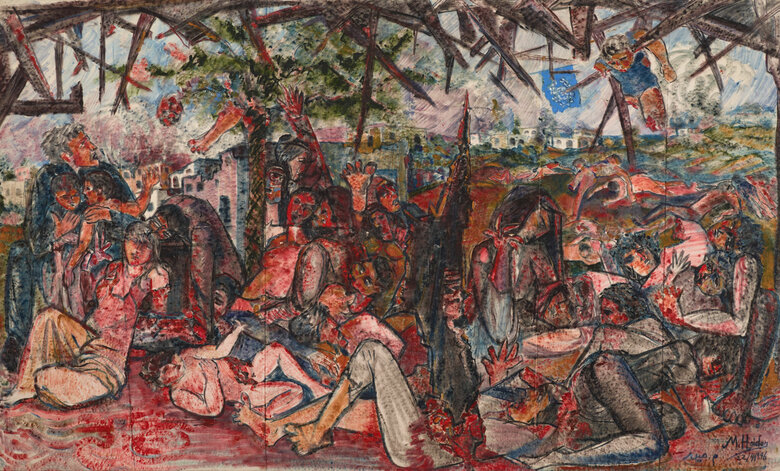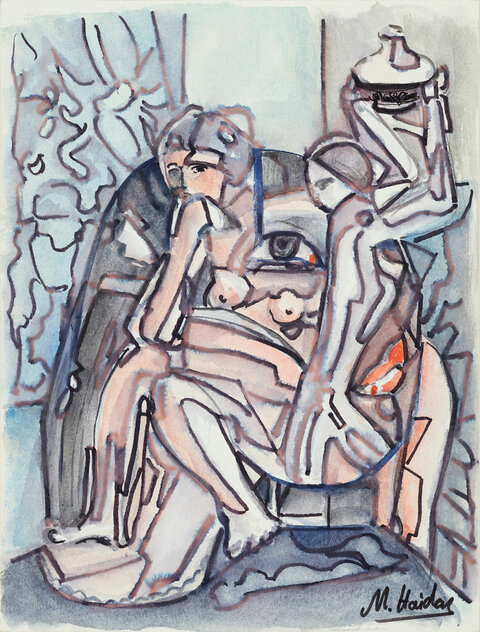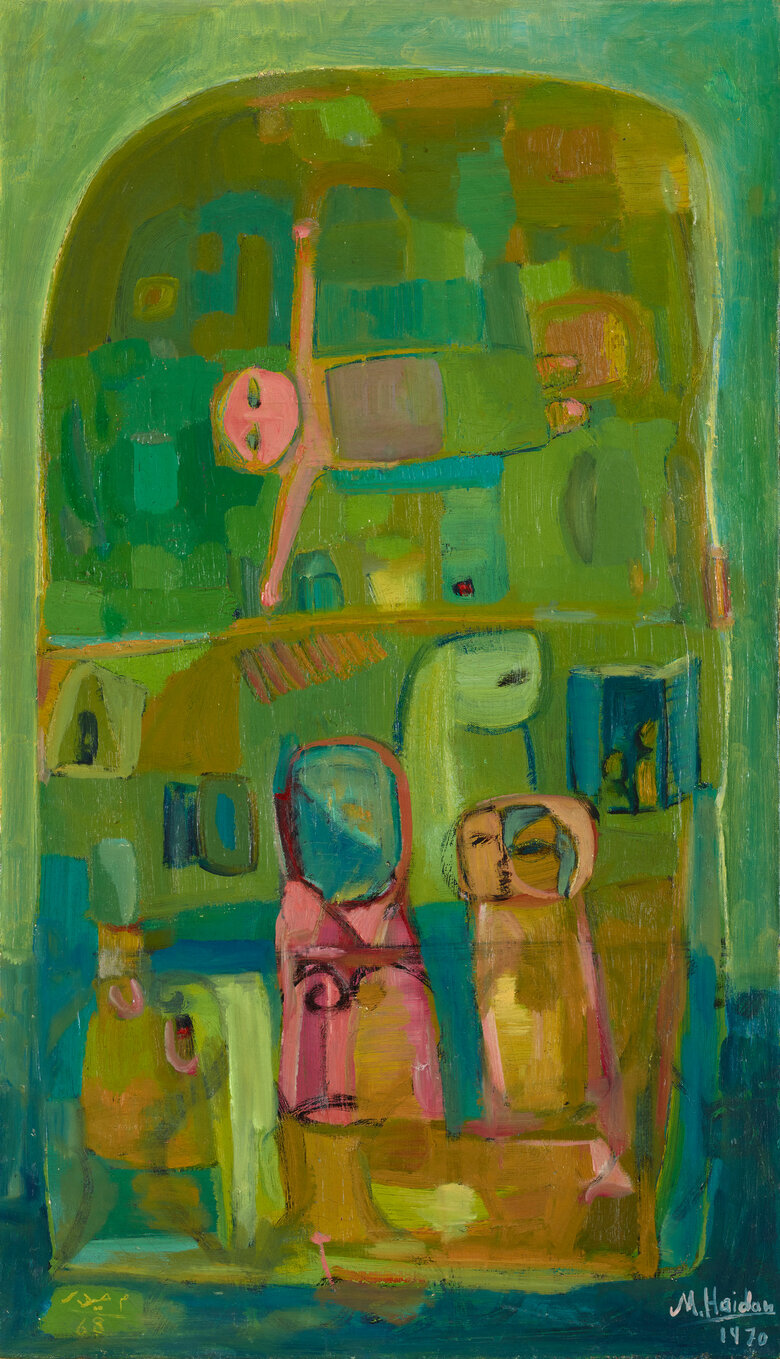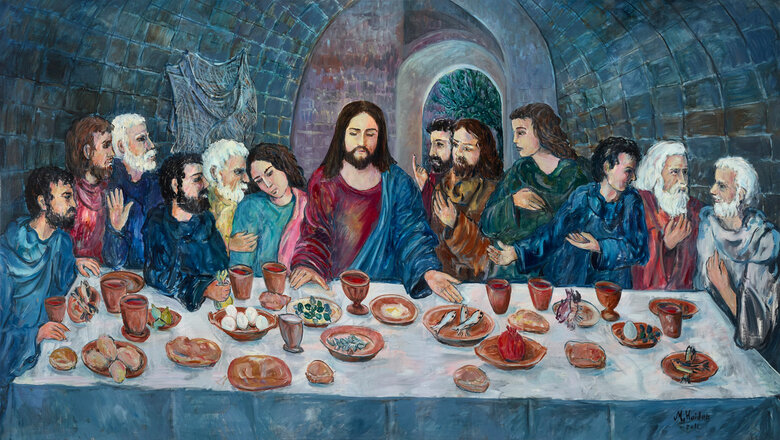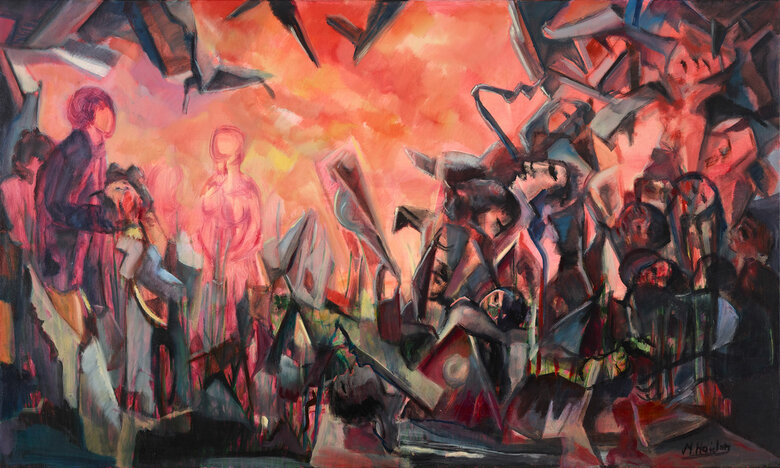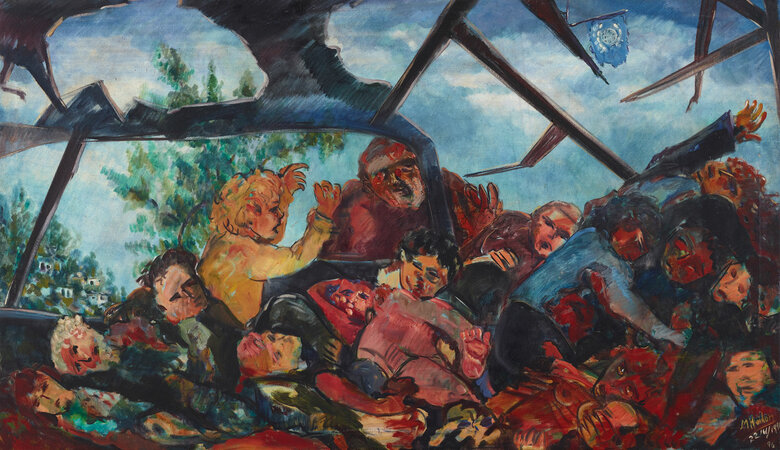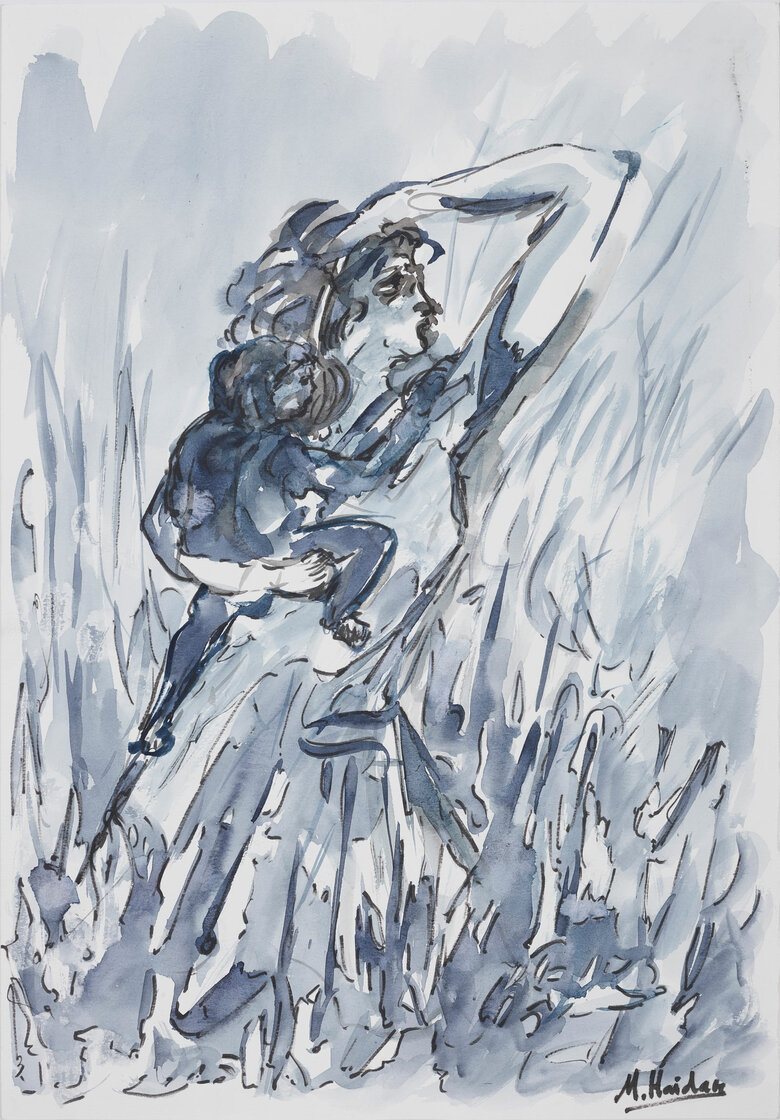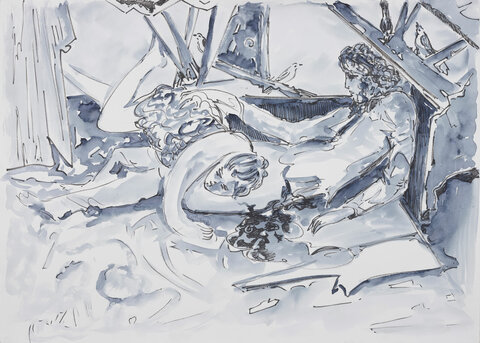Written by Zeid El Amine Born in Baalbek in 1944, Moustafa Haidar grew up surrounded by the rugged mountains of the Beqaa Valley, though he always longed for the sea. In 1958 Haidar journeyed to...


MOUSTAFA HAIDAR, Lebanon (1944)
Bio
Written by Zeid El Amine
Born in Baalbek in 1944, Moustafa Haidar grew up surrounded by the rugged mountains of the Beqaa Valley, though he always longed for the sea. In 1958 Haidar journeyed to Beirut at age 14 to enroll at the Académie Libanaise des Beaux-Arts (ALBA). His enrollment was first denied by director Alexis Boutros, citing his young age and lack of secondary education. As a corrective, the painter and professor César Gemayel enrolled him at Al Ahliya School in Beirut’s Mazraa neighborhood to complete his high school degree, and concurrently at ALBA to study painting. Mentored by Nicolas Nammar, he studied alongside Amine El Bacha and Hassan Jouni, painting for roughly fifteen hours a day. After graduating from ALBA in 1962, Haidar worked as a caricaturist at Al Ahad magazine. In 1963, he was awarded the bronze medal at the Alexandria Biennale for Mediterranean Countries. He taught at the Lebanese University from 1967 to 1990, as well as in public high schools in South Lebanon.
Haidar came of age in a nationalistic atmosphere that rejected colonial dependency. Inspired by his father, who spent a decade in prison due to revolutionary organizing against the French, Haidar used painting to search for truth and liberate man from self-enslavement. Personally and artistically, the artist remained connected to his cultural roots in the Beqaa Valley, and the folk history of Lebanon more generally. In 1989, for example, he created a mural depicting the abduction of Europa, a mythical Phoenician princess, by the god Zeus. He painted this well-known mythological scene on a wall facing a cemetery in Tyre, where Europa is said to have been born.
In April 1996, Haidar witnessed Israeli helicopters open fire on an ambulance that had been transporting civilians from Al-Mansouri to Tyre, killing four children and two women. Moments after the attack, Haidar headed to the scene, and as a gesture of resistance, exposed himself to an area shelled by Israeli forces to exhibit his paintings in the street. The Qana massacre took place only five days later, during which hundreds of Lebanese civilians taking shelter at the village’s United Nations compound lost their lives to Israeli strikes. Haidar described the scene as “a sea of blood and corpses.” That same day, the artist defiantly set up a canvas on a sidewalk and depicted the scene using diluted oil paint, all while Israeli helicopters flew overhead.
Haidar is known for his skill in coloring and transparency. His one-stroke rule soaks his watercolor paintings in light, and he achieves it by impulsively selecting colors and mixing only two at a time to access their infinite derivatives. Haidar uses a similar palette to depict both Lebanese landscapes and portraits of women. In his two 1996 solo exhibitions, Watercolors of Memory and the South and Watercolors of Memory and Color, he painted his female subjects with the same yellow-orange he used to portray natural light. These exhibitions consisted of over one hundred watercolors, and his affinity for the medium earned him the moniker “Father of Watercolor.”
In 1975, Paul Guiragossian (1926-1993) was receiving treatment for a leg injury at the University of Illinois Hospital in Chicago, where he saw a watercolor painting that reminded him of Haidar’s work. Guiragossian then discovered that the hospital owns 24 of Haidar’s aquarelles, whose calming and vivid colors assist patients in the healing process.
In addition to watercolor and oil paint, Haidar uses acrylics, pastels and India ink. Across these different media, Haidar portrays landscapes, nude figures, and politically-charged scenes of tragedy alike in a gestural, unembellished style. The artist’s priority lies not in the details of a given form as much as in the spontaneity of his color choices, including his use of lilac in watercolors, or in the distortion of perspective in his depictions of violence. Haidar breaks his subjects down to simple forms, using a play between loose, fluid brushstrokes and harsh, jagged angles to imbue each of his works with an emotional overtone. This emotive style does not oppose his formal training, but it allows for the senses of his inner self to take precedence. His creations exaggerate emotions while tending toward realism, as he believes truth exists in both imagination and reality.
Haidar lives in Tyre and keeps a studio in Sidon.
Sources
Bardaouil, Sam & Fellrath, Till. Paul Guiragossian Displacing Modernity.Milan: SilvanaEditoriale, 2018.
Ben Fatima, Bushra. “ . "الفنان التشكيلي اللبناني مصطفى حيدر”, Arts Gulf (2017). http://artsgulf.com/articles/671916.html
الأمل، ضحى عبد الرؤوف. "معرض للفنان مصطفى حيدر... الحس الفني و الاتجاهات التشكيلية." اللواء August 12 2016
"محترف صور الفني كرم الفنان القدير الاستاذ مصطفى حيدر ", Ya Sour(2013). http://www.yasour.org/2012/list.php?go=fullnews&newsid=16220
الأمل، ضحى عبد الرؤوف. "معرض الفنان مصطفى حيدر... زمنية اللوحة تحكي الحضارات الأتية." اللواء5-7-2013
حيدر، صفوان. "مصطفى حيدر: خيالي التشكيلي أكبر من لمسات فرشتاي." السفير 2012
زعيتر، سامر. "وزيرة التربية رعت إفتتاح معرض الفنان مصطفى حيدر." اللواء 11-11-2008
زيات، محمود. "و افتتحت معرضاً في صيدا." الديار 11-11-2008
و معرض لمصطفى حيدر في خان الافرنج." المستقبل 11-11-2008 “
نعيم، رأفت. "إفتتاح معرض مائيات في خان الإفرنج في مدينة صيدا." Saida Online (2008) http://www.saidaonline.com/news.php?go=fullnews&newsid=25418
فقندش، علي. "القنصل اللبناني يفتتح المعرض الشخصي للفنان العالمي مصطفى حيدر." عكاظ . 5-12-1999
مائيات الذاكرة و الجنوب لمصطفى حيدر." مجلة الجيش. 1996 “
غانم، زهير. "الطبيعة برؤيا مشرقة و نمنمة شفافة." 1996
اسطفان، ايلي. "مصطفى حيدر في ' مائيات الذاكرة و الجنوب ' حوار الأرض و السماء و الحركة اللونية." 1996
زعيتر، ثريا حسن. "الفنان مصطفى حيدر غمس ريشته في وجع الجنوب و نفضها لوحة جسدت معالم مجزرتي قانا و المنصوري." اللواء . 15-5-1995
أضواء جنوبية لمصطفى حيدر." النهار. 14-3-1994 “
الرسام الثائر مصطفى حيدر." الدنيا. 31-3-1994 “
عبود، حمزة. "الفنان مصطفى حيدر: ' مقالة ' الحجر." 9-4-1994
مصطفى حيدر، صقل الريشة في الجنوب أحلم بالبحر و الاقتراب منه." النهار. 3-1-1992 “
الشامي، مردوك. "الفنان التشكيلي مصطفى حيدر. مقياس اللوحة هو الابداع." البناء. 30-5-1992
"المعرض الخامس للفنون التشكيلية بقاعي من نشاطات ' ندوة الخميس '." النهار. 20-8-1992
مصطفى حيدر ' يعرب '،" مجلة الأمن 1992 “
مصطفى حيدر في ' دار الندوة ' وشم على ذاكرة الحياة." الأنوار. 1992 “
بزون، أحمد. "مصطفى حيدر في معرض الأخير شفافية اللوحة المائية." السفير. 16-3-1991
الفنان اللبناني مصطفى حيدر ل' العالم ' : لا يجوز إطلاق تسمية فن إسلامي على فنون الزخرفة و “ التزيين." العالم. 16-3-1991
الفنان مصطفى حيدر ل ' البلاد ' : محاولة اخراجي من الطفولة تعني موت كفنان." البلاد “
كلش، علي. "الرسام مصطفى حيدر." الحدائق
"نشاطات المركز الثقافي الفرنسي في صيدا." صيدا عبر العالم
"مائيات مصطفى حيدر تتخطى الناحية البصرية للمنظر الطبيعي." الشراء. 22-4-1984
“Moustafa Haydar”. National Virtual Museum. http://artmodernemv.gov.lb/
CV
Selected Solo Exhibitions
2016
Beirut, Lebanon
2013
Beirut, Lebanon
2012
Beirut, Lebanon
2008
“مائيات”, Sidon, Lebanon
1999
Italian Cultural Center, Jeddah, KSA
1996
"مائيات الذاكرة و اللون", Lebanon
"مائيات الذاكرة و الجنوب" , Galerie d’Art Bekhazi, Beirut, Lebanon
1994
"أضواء جنوبية", Tyre, Lebanon
"جداريات", Tyre, Lebanon
1992
"مناخات تعبيرية", Dar el Nadwa, Beirut, Lebanon
"مناخات", French Cultural Center, Sidon, Lebanon
1986
American University of Beirut, Lebanon
1984
"جنوبيات", Tyre, Lebanon
1980
Salon of the Lebanese Artists Association- Painters and Sculptors, Lebanon
1978
Paris, France
Salon of the Lebanese Artists Association- Painters and Sculptors, Lebanon
1974
The Carlton Hotel
1972
Kansas, USA
1971
Ibrahim Eid’s house, Lebanon
1959
UNESCO Palace, Beirut Lebanon
Selected Group Exhibitions
1992
"ندوة الخميس", Baalbek Lebanon
1974
"البندقية"
1962
” البندقية"
“معارض المجلس الثقافي للبنان الجنوبي “, Tyre, Lebanon
Awards
1973
Bronze Medal, Alexandria Biennial, Egypt
Collections
Ramzi & Saeda Dalloul Art Foundation, Beirut Lebanon
Farhat Art Museum, Beirut Lebanon
Press
محترف صور الفني كرم الفنان القدير الاستاذ مصطفى حيدر
yasour.org, Arabic, 2013
الفنان التشكيلي اللبناني مصطفى حيدر
بشرى بن فاطمة
artsgulf.com, Arabic, 2017
الفنان اللبناني مصطفى حيدر ل"العالم": لا يجوز إطلاق تسمية "فن إسلامي" على فنون الزخرفة و التزيين
العالم, Arabic, 1991
From Artist’s Archives
الفنان التشكيلي مصطفى حيدر . مقياس اللوحة هو الابداع
مردوك الشامي
البناء, Arabic, 1992
From Artist’s Archives
الفنان مصطفى حيدر ل"البلاد" : محاولة اخراجي من الطفولة تعني موت كفنان
Al Bilad, Arabic
From Artist’s Archives
الفنان مصطفى حيدر غمس ريشته في وجع الجنوب و نفضها لوحة جسدت معالم مجزرتي قانا و المنصوري
ثريا حسن زعيتر
اللواء, Arabic, 1995
معرض الفنان مصطفى حيدر .. زمنية اللوحة تحاكي الحضارات الأتية
ضحى عبد الرؤوف الأمل
اللواء, Arabic, 2013
٣ مؤسسات تتنافس على اقتنائها جدارية "قانا" على خطى "جرنيكا"
كل الاسرة, Arabic, 1997
مصطفى حيدر في "مائيات الذاكرة و الجنوب" حوار الأرض و السماء و الحركة اللونية
ايلي اسطفان
Arabic, 1996
القنصل اللبناني يفتتح المعرض الشخصي للفنان العالمي مصطفى حيدر
علي فقندش
جريدة عكاظ, Arabic, 1999
إفتتاح معرض مائيات في خان الأفرنج في مدينة صيدا
رأفت نعيم
saidaonline, Arabic, 2008
معرض للفنان مصطفى حيدر ... الحس الفني و الاتجاهات التشكيلية
ضحى عبد الرؤوف الأمل
اللواء, Arabic, 2016
MOUSTAFA HAIDAR Artwork
Become a Member
Join us in our endless discovery of modern and contemporary Arab art
Become a Member
Get updates from DAF
Follow Artists
Save your favourite Artworks
Share your perspectives on Artworks
Be part of our community
It's Free!
We value your privacy
TermsCookiesPrivacy Policies
Become a Member
Get updates from DAF
Follow Artists
Save your favourite Artworks
Share your perspectives on Artworks
Be part of our community
It's Free!
We value your privacy
TermsCookiesPrivacy Policies
Become a Member
Get updates from DAF
Follow Artists
Save your favourite Artworks
Share your perspectives on Artworks
Be part of our community
It's Free!
We value your privacy
TermsCookiesPrivacy Policies
Welcome to the Dalloul Art Foundation
Thank you for joining our community
If you have entered your email to become a member of the Dalloul Art Foundation, please click the button below to confirm your email and agree to our Terms, Cookie & Privacy policies.
We value your privacy, see how
Become a Member
Get updates from DAF
Follow Artists
Save your favourite Artworks
Share your perspectives on Artworks
Be part of our community
It's Free!
We value your privacy
TermsCookiesPrivacy Policies

